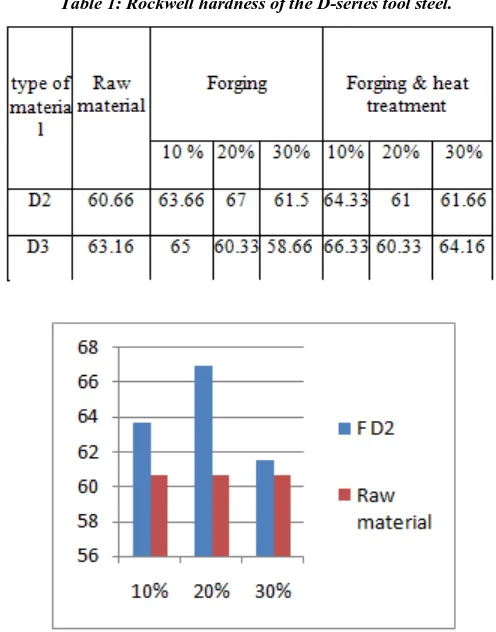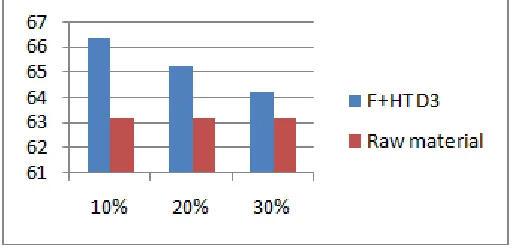INTERNATIONAL JOURNAL OF ENGINEERING SCIENCES & MANAGEMENT 106
I
NTERNATIONAL
J
OURNAL OF
E
NGINEERING
S
CIENCES &
M
ANAGEMENT
A COMPARATIVE STUDY ON PROPERTIES OF FORGED AND HEAT TREATED D
TYPE TOOL STEEL
T S Siddalingaprasad1 and Dr. H S Shivashankar2
1
Associate professor,Mechanical Engineering Department, KIT Tiptur. 2
Professor, Mechanical Engineering Department, SIT Tumkur
ABSTRACT
In this work an attempt has been made to improve the properties of cutting tool like hardness, toughness & wear resistance by forging & heat treatment process. Here we have selected D-Series tool steel (D2,D3) for our project, These tool steels are used in forging dies, die-casting die blocks, drawing dies etc., hence we made an attempt to check whether these tool steel can be used as a cutting tool at high temperature. The experiment evaluates Rockwell hardness test, toughness test & wear test. The result reveals that, hardness of D-series tool steels improved by forging & heat treatment process than it was in raw material case & the heat treated D series-tool can be operated at high temperature without wear.
Keywords: D-type tool steels, forging, heat treatment, hardness, toughness tests
I. INTRODUCTION
D-type tool steels contain between 10% and 18% chromium. These steels retain their hardness up to a temperature of 425 °C (797 °F). Common applications for these tool steels include forging dies, die-casting die blocks, and drawing dies. Due to their high chromium content, certain D-type tool steels are often considered stainless or semi-stainless; however their corrosion resistance is very limited due to the precipitation of the majority of their chromium and carbon constituents as carbides. The heat treatment to which a tool has been subjected has a marked influence on cutting performance of tool steel. The general heat treatment schedules applied to tool steels are shown in figure 1.1.
figure 1. Heat treatment schedules applied to tool steels
INTERNATIONAL JOURNAL OF ENGINEERING SCIENCES & MANAGEMENT 107
which can lead to problems with cracking, retained austenite, and excessive distortion. Relatively slow oil quenching or air cooling for hardening of tool steels can lead to grain boundary carbide formation, which makes tool steel susceptible to intergranular failure. The high harden ability of tool steels effectively suppresses perlite formation at al1 cooling rates. Bainite formation is also readily suppressed except in heavy sections, which cool slowly. However by slow cooling, the formation of carbides on austenite grain boundaries is difficult to suppress. Small amounts of carbides do not significantly affect hardness but may lower tool steel fracture resistance, leading to quench cracking, and intergranular fracture of tool steels and reduced performance of hot work tool steels. A number of investigations have shown that the presence of the grain boundary carbides significantly reduces toughness of hardened and tempered tool steels. Tool steels hardened in an oxidizing atmosphere scale freely; the D2 and D3 tool steels cannot be hardened in this manner without excessive decarburization. Steels that can be hardened satisfactorily in an oxidizing atmosphere generally have low chromium content (1% or less) and do not require a high hardening temperature (no greater than 870°C). In order to protect the tool steel surface from decarburization and scaling during heat treatment, the furnace medium must be kept neutral. Otherwise decarburization will lead to soft surfaces and cause cracking due to the formation of residual tensile stresses in the surface. A possible explanation of this mechanism is that the reductions in carbon content raise the martensite transformation temperature. Thus, on quenching, the outer layers transform first at a much higher temperature, and when the core transforms and expands, it puts the outer layer in tension.
II. METHOD AND MATERIAL
The raw materials selected are D-series tool steels (D2, D3,). There composition is shown in table 2.1 and 2.2. The selected D2 and D3 tool steel images are shown in figures 2.1 and 2.2. D-series tool steels are selected because, According to American iron and steel institute (AISI), D2 & D3 steel contains high-carbon, high-chromium alloyed with molybdenum, vanadium and characterized by:
1. High wear resistance.
2. High compressive strength.
3. Good through-hardening properties.
4. High stability in hardening.
5. Good resistance to tempering-back.
6. Low cost compare to other tool steels.
7. Easily available.
AISI D2 & D3 steels are the most widely used steel in the industry. AISI D2 & D3 steels are recommended for tools requiring very high wear resistance, combined with moderate toughness, these steels are most suitable for testing. Forging process:
D type tool steels D2and D3 are subjected to Press Forging individually by using belt drop hammers of weight 500N shown in figure 2.5. The materials are hot forged by heating it to above itsre-crystallization temperature shown in figure 2.4. In process the materials is heated in furnace to 1000oC shown in figure 2.3.The Dimension of D-type tool steel before forging is 30*30*100 (b * h * l). The Dimension of D-type tool steel after forging is varied 10,20 and 30 percentage shown in figure 2.6.
Heat Treatment process
Heat treatment is a process where the material is subjected to certain temperature and cooling in different ways. Heat treatment involves heating or chilling the material normally to extreme temperatures. It leads to alter the physical properties of a material, this helps to harden or soften the material. There are several Heat treatment techniques, some of them are annealing, Quenching, nitriding, case hardening, precipitation decarburization will lead to soft surfaces and cause cracking due to the formation of residual tensile stresses in the surface. A possible explanation of this mechanism is that the reductions in carbon content raise the martensite transformation temperature. Thus, on quenching, the outer layers transform first at a much higher temperature, and when the core transforms and expands, it puts the outer layer in tension.
INTERNATIONAL JOURNAL OF ENGINEERING SCIENCES & MANAGEMENT 108
are placed in Electrically Heated Coil furnaces as in figure 2.7and 2.8. Then the material is heated to the prescribed temperature as in figure 2.9. After attaining the prescribed temperature the red heated material as in figure 2.10 and 2.11 is placed in air blower as shown in figures 2.12 and 2.13. Then the material is allowed to cool rapidly as in figure 2.14.
There are several types quenching process they are:
1. Air Quenching
2. Water Quenching
3. Oil Quenching
Air quenching is the heat treatment process used in our project work. Air quenching is heating the tool steel material to high temperature and cooling rapidly by blowing air forcibly. For heat treatment process the below conditions were followed
1. Heating temperature – 750 to 8000c.
2. Type of furnace – Electrical induction Coil furnaces.
3. Used Air blower Specification – Voltage = 220 to 440V. Current = 3.6A Speed = 2800 rpm.
4. Cooling time – 30min.
III. RESULTS AND DISCUSSION
Hardness test
Table 1: Rockwell hardness of the D-series tool steel.
INTERNATIONAL JOURNAL OF ENGINEERING SCIENCES & MANAGEMENT 109
Figure 3: Hardness variation between forged+heat treated D2 steel v/s Raw material.
Figure 4: Hardness variation between forged+heat treated D3 steel v/s Raw material.
INTERNATIONAL JOURNAL OF ENGINEERING SCIENCES & MANAGEMENT 110
Figure 6:Impact strength variation between forged D2 steel v/s Raw material.
Figure 7:Impact strength variation between forged D3 steel v/s Raw material.
INTERNATIONAL JOURNAL OF ENGINEERING SCIENCES & MANAGEMENT 111
Fig 9: wear rate of D2 specimen at load 2kg,5mins, at room temperature
Fig 10: wear rate of D2 specimen at load 2kg, 10mins, at room temperature
INTERNATIONAL JOURNAL OF ENGINEERING SCIENCES & MANAGEMENT 112
Fig 12: wear rate of D3 specimen at load 2kg, 10mins, at room temperature
IV. CONCLUSION
From the above results it is observed that hardness value is more in heat treated and forged heat treated for all D series tool steels. Hardness is improved in D2 and D3toolsteels at forged + heattreated type. In wear test it is observed that heat treated tools are less worn out compared to others.Also from graph it is observed that at room temperature in both D2 and D3 type Forged +Heat treated tool steels will be less worn out. Future work has to be carried out to concentrate on high temperature wear, toughness and to improve toughness of the material, Along with this a tool has to be made with standard tool nomenclature and tool life has to be calculated
REFERENCES
1. C. Huang, Z. Chen, T.A. Dean, M.H. Loretto “Effect of post-forging heat treatment on the microstructure and
room temperature tensile properties in Ti-25 Al-10Nb-3V-1Mo (super α2)”
2. Prof. Dr-Ing. DiethardThomas FETTE GmbH, 21493 Schwarzenbek, grabauergermany, “Application of HSS
cutting toolsin the Mechanical Engineering Industry”
3. David vinar. “Industrial Diamonds in Cutting Tool Applications”
4. V. Leshchynskya, M. Ignatieva, H. Wiśniewska-Weinerta, J. Borowskia, T. Rybaka,*, I. Dobrovnikb
5. “Forging tools modification with graphene-like solid lubricant nanoparticles”
6. TaylanAltan and ManasShirgaokar, The Ohio State University “Selection of Forging Equipment”
7. Patricia Miller Senior technical manager Bohler-Uddeholm corporation “Forging- Die material development :
from research implementation”
8. AshwinPolishetty, Dr. Moshe Goldberg and Dr. Guy Littlefair “Wear Characteristics of Ultra-Hard
CuttingTools when Machining Austempered Ductile Iron”
9. Ali Mkaddem, Anne Huguet, Mohamed El Mansori “Recrystallisation of austenite grain when non-isotherm steel working: Effects of thermal kinetics and deformation-based mechanisms”
10. FarhadNabhani, School of Science and Technology, University of Teesside, Middlesborough TS1 3BA, UK “Wear mechanisms of ultra-hard cutting tools materials”





